Vincent Kompany’s tactical blueprint at Bayern Munich has introduced a fresh, innovative approach to the team’s style of play. Known for his intelligence both as a player and now as a manager, Kompany has implemented a system that emphasizes pressing, positional fluidity, and dynamic build-up play. This article breaks down the key elements of his tactics, from how Bayern Munich operates in various phases of the game to the specific roles entrusted to key players under his system. Let’s dive into the strategies shaping this new era of Bayern football.
Build-up
Low Build-up
Vincent Kompany sets his team up in a 1-4-2-2-2 formation in the low build-up. He uses two dropping strikers/number-tens and looks to attract opposition players to open up the space in behind for the wingers to exploit.
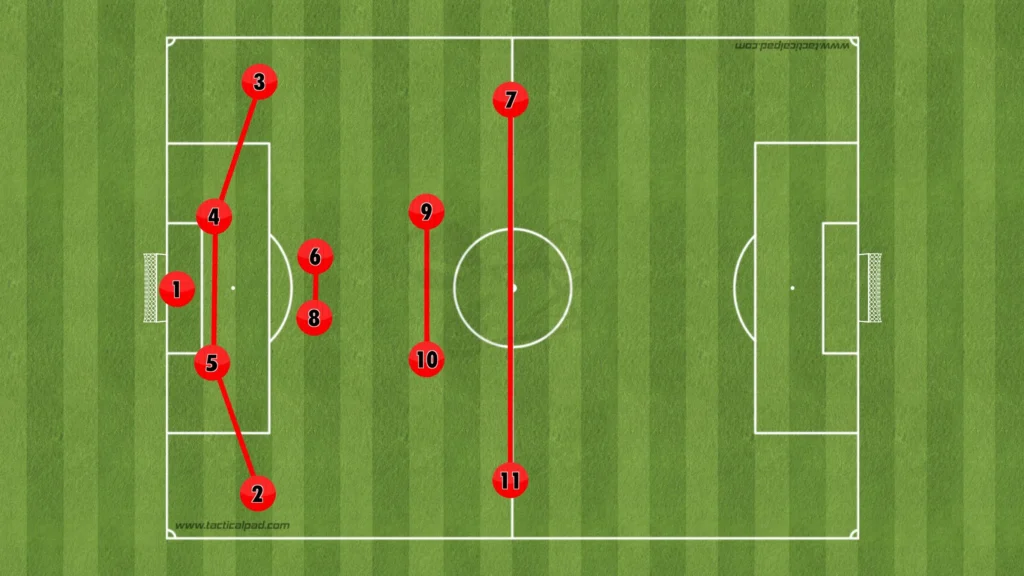
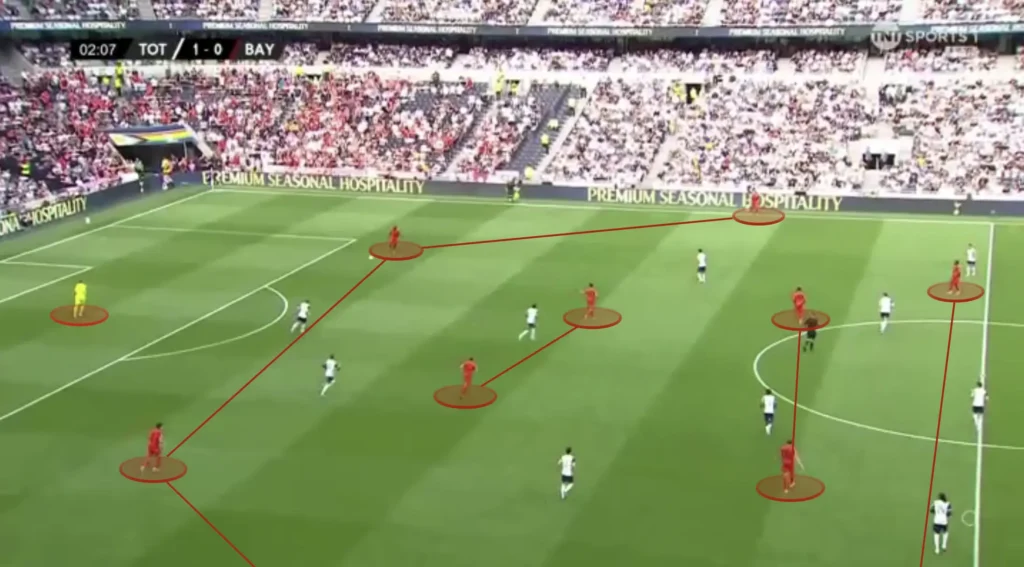
This structure with two dropping strikers and two high wingers, popularized by Roberto De Zerbi, questions the opposition center-backs, forcing them to make difficult decisions. If they push up on the dropping strikers, the space behind them opens up, giving the winger a 1v1 against the fullback in a massive space.
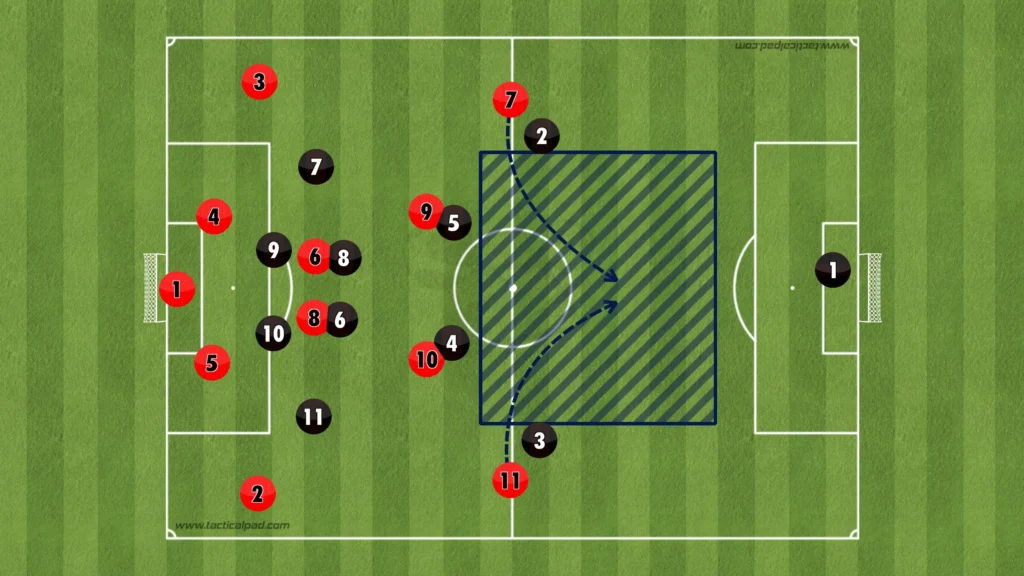
However, if they do not push up on the strikers, a numerical superiority is created in the midfield, allowing Bayern to play through the press.
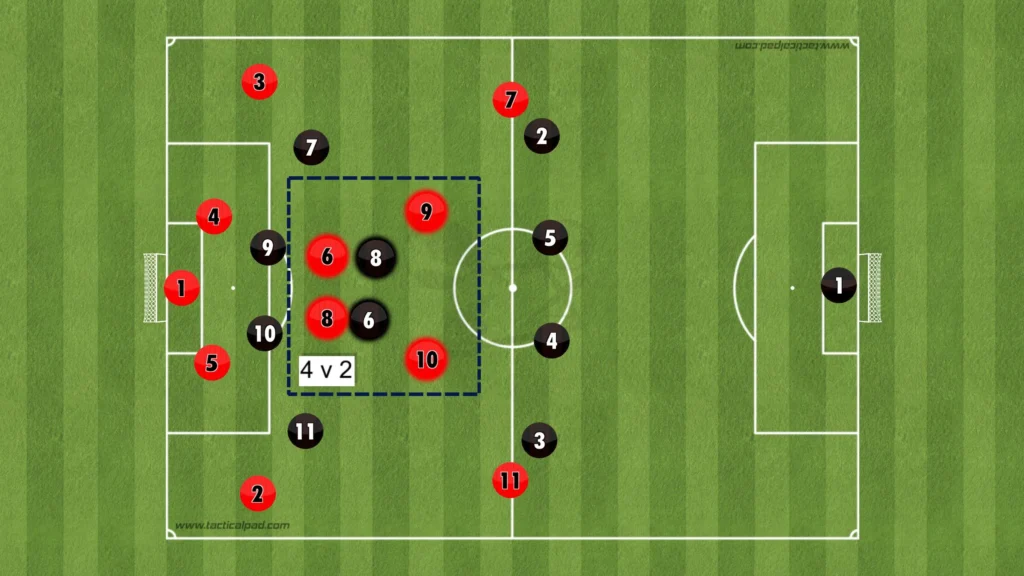
When Bayern Munich beat the press, the attackers will immediately make runs in behind, looking to exploit the space behind the opposition’s backline.
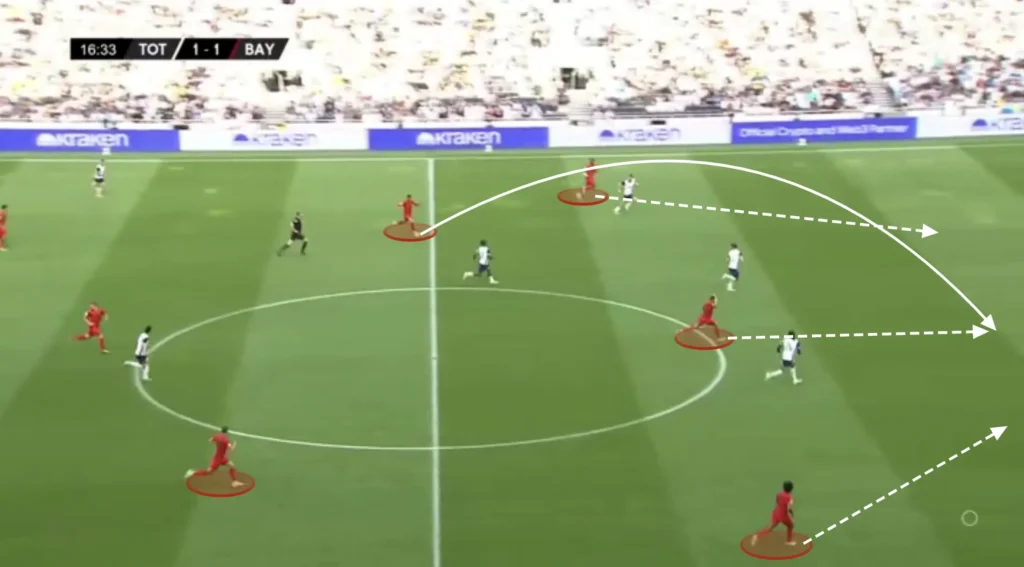
Bayern are also not afraid to be more direct in their low build-up. If the opposition comes up and presses man-to-man, there will be numerical equality up top with Bayern’s attackers against the opposition defenders. The goalkeeper will sometimes find an early longer ball up to the attackers, aiming to win 2v2 or 3v3 situations. The Bayern attackers have good individual quality and will often win these battles to create goalscoring opportunities.
High Build-up
In the high build-up, Bayern Munich usually rotate into a 1-2-3-2-3 formation.
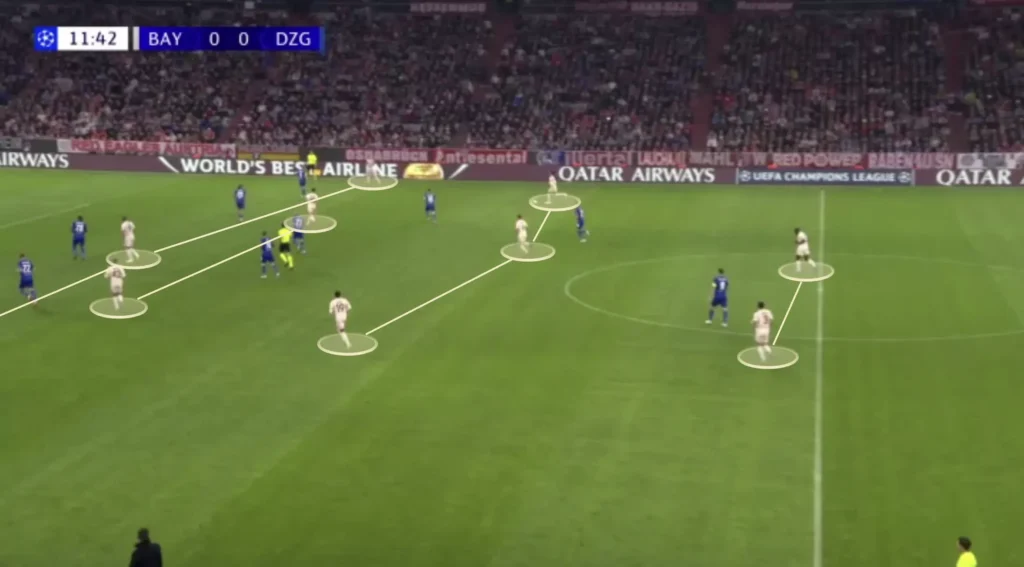
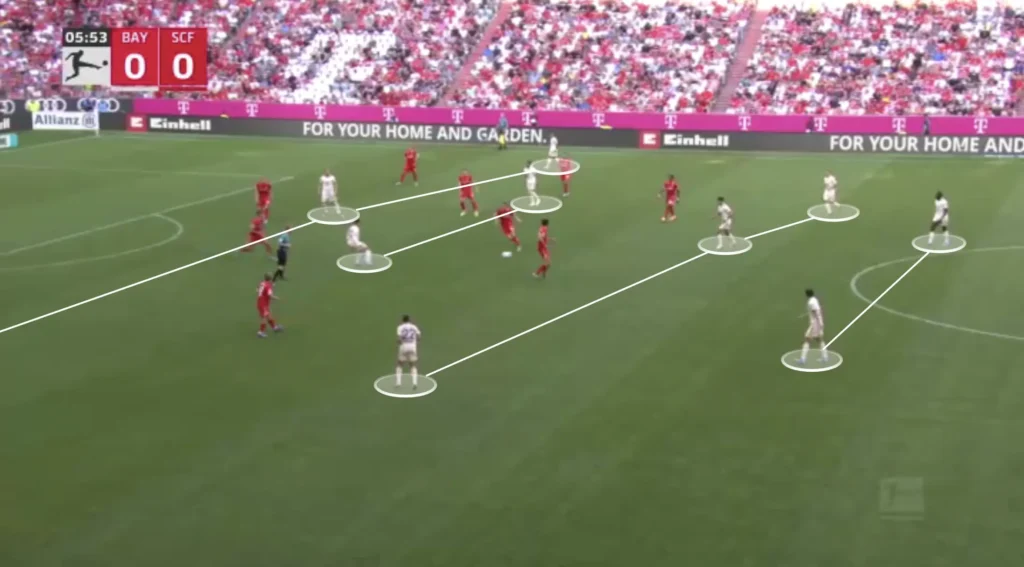
The 1-2-3-2-3/1-2-3-5 formation allows for a strong presence in the midfield, which helps in controlling the game and dictating the tempo. The two central defenders provide a solid foundation for recycling possession, while the three holding midfielders can effectively link play between defense and attack. The five forward players, including wingers and strikers, stretch the opposition’s defense, creating space and overloads in key areas.
Fluidity
Bayern Munich’s fluidity in the build-up under Vincent Kompany has been a key aspect of their tactical evolution. The team often adopts a dynamic approach, shifting between formations to create numerical advantages and exploit spaces. Kompany’s focus is always to get the players into their best positions, where they can make the most out of their individual skills. He emphasizes versatility, with players interchanging positions seamlessly to maintain possession and disrupt the opposition’s defensive structure. The fullbacks often move into midfield, attackers switch positions with each other, and central midfielders drop deep to assist in ball progression. This flexibility creates numerical superiority in different areas, allowing Bayern to bypass the opposition’s press while maintaining control. The movement is coordinated and dynamic, with constant interchanging between lines, making it difficult for opponents to predict or disrupt Bayern’s build-up play.
While it demands a lot of technical and tactical skills from the players, this fluidity has created new dynamics for Bayern’s attacking style, offering new solutions and ways of beating the opposition’s press. It enhances their ability to control the game while opening up opportunities for incisive passes and creative plays.
Numerical Advantage in the midfield
Regardless of the formation, Bayern Munich will have many players in the center. Kompany usually has a winger on each side and positions the remaining eight players in the middle. Having only the two wingers out wide and the rest in the middle creates more options in the center and less space between the players. Kompany likes this because he prioritizes playing through the middle. He needs one player out wide to pull the opposition apart while the rest create numerical advantages in the midfield areas.
When a team outnumbers the opposition in the midfield, it can more easily retain the ball, exploit spaces, and progress the ball through the center. This advantage forces the opposing team to chase the game, which can lead to defensive errors and create opportunities for breaking down their defense. At the same time, it builds good conditions in defensive transitions since it allows more players to counterpress when they lose the ball.
Another purpose for keeping many players in the middle is to shorten the distance between them. This shortens the length of the passes, which naturally shortens the time between passes. This means the opposition players will have less time to push up and press, giving the Bayern players more time and control.
Rest-Defence
Kompany also wants many players close to the center to create a good rest-defence structure. A good rest-defence structure is crucial for maintaining balance and preventing counterattacks when the team is in possession. Having many players in the middle builds good conditions in defensive transitions, allowing more players to counterpress when losing the ball. The two center-backs and three holding midfielders form the core of the rest-defence, as they are well-positioned to deal with any potential loss of the ball. When losing possession, the four or five Bayern players closest will immediately jump on the opposition player with the ball and close the distance to cut off any passing lanes. This approach disrupts the opponent’s transition from defense to attack, forcing errors and creating opportunities to regain control of the ball.
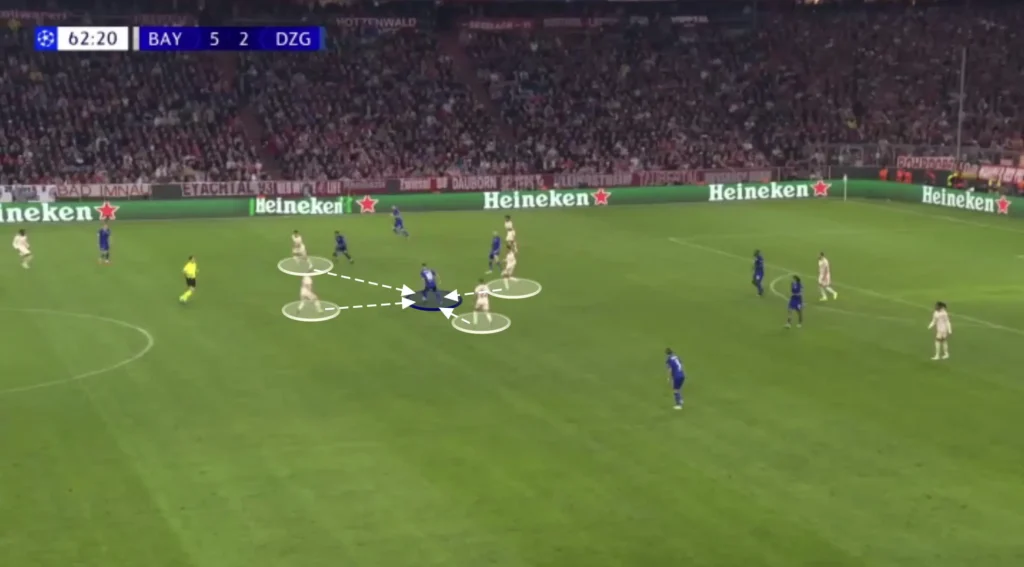
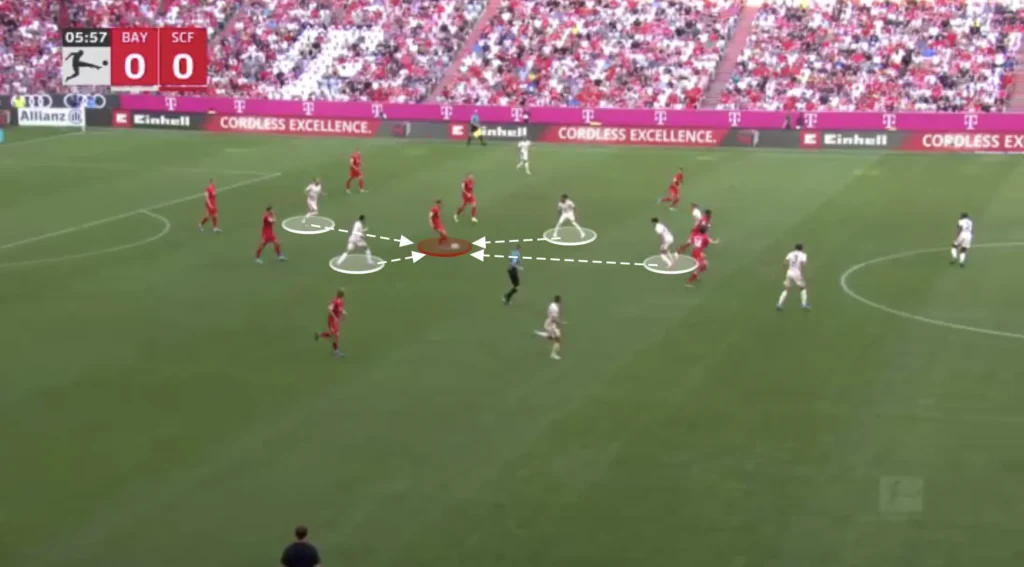
Counterpressing like this keeps Bayern Munich on the front foot, allowing them to dominate possession and create more scoring opportunities. However, it requires exceptional fitness, tactical discipline, and teamwork.
High Backline
A massive aspect of Kompany’s high possession build-up is to have the defenders high up. This helps in the counterpress because they get closer to the center. Having more players close to the center who can win the ball back makes it difficult for the opposition to do anything when they win possession. Furthermore, the high backline shortens the distance between players, shortening the time and length of the passes and preventing the opposition from pushing up their defense.
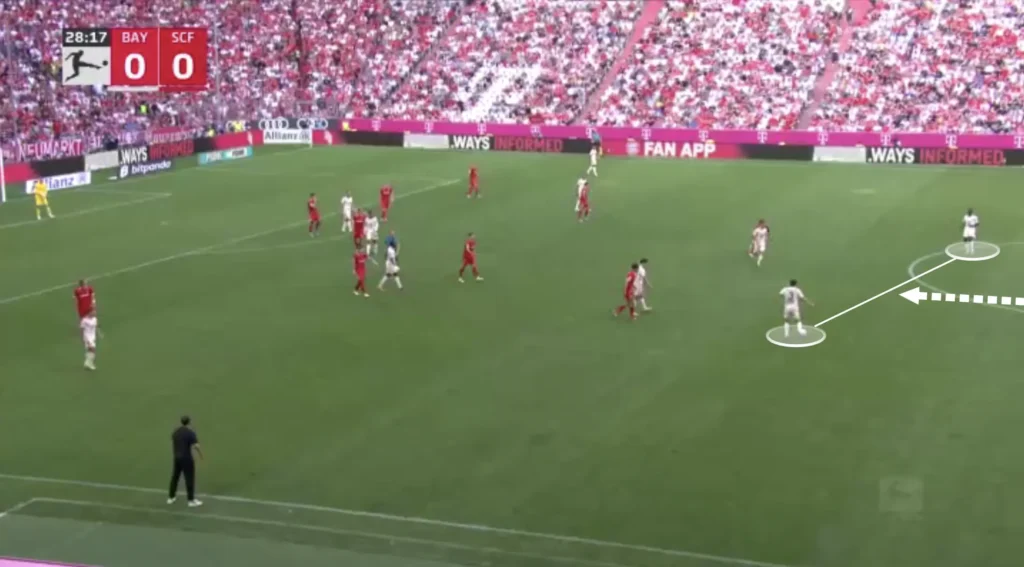
Using the Goalkeeper
Vincent Kompany is a big fan of using the goalkeeper in the build-up. Using the goalkeeper in the build-up phase offers numerous tactical advantages. By involving the goalkeeper, Bayern Munich can create numerical superiority at the back, making it easier to evade the opponent’s press and maintain possession. This additional player allows for more passing options, reducing the risk of losing possession and enabling smoother transitions from defense to attack. The goalkeeper can also act as a pivot, switching play across the field to exploit weak points in the opposition’s formation. Furthermore, involving the goalkeeper helps in drawing the opposition forward, creating space higher up the pitch for attackers to exploit.
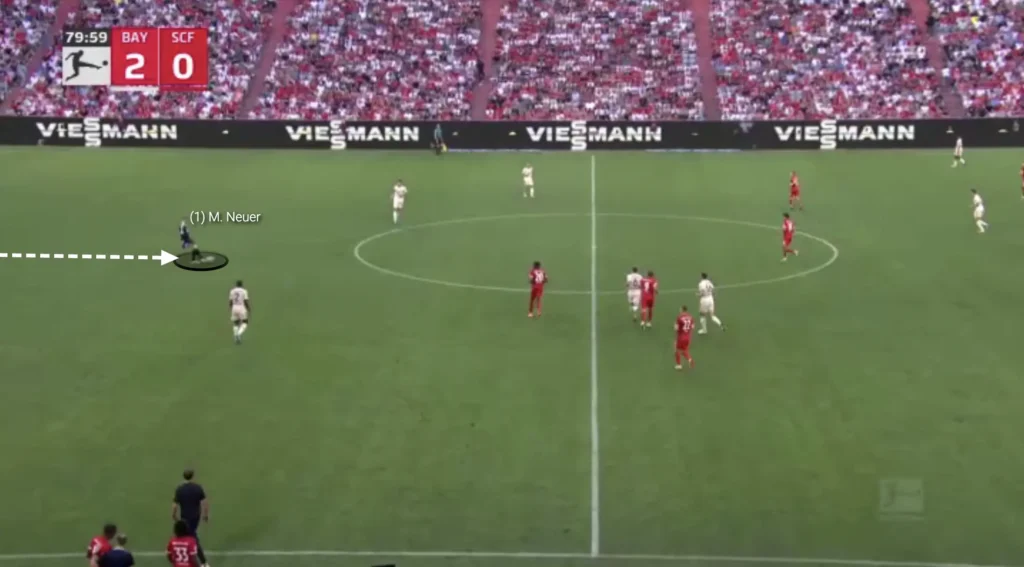
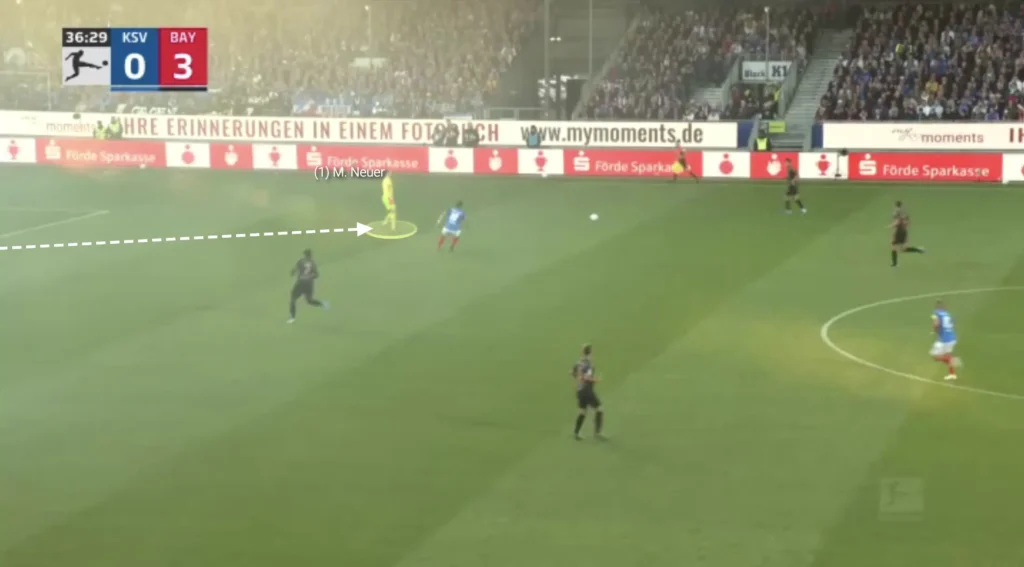
Attackers Dropping
Jamal Musiala plays a pivotal role in Bayern Munich’s build-up by frequently dropping deeper to facilitate ball progression. His ability to receive the ball in tight spaces and turn under pressure makes him a key outlet when Bayern looks to bypass opposition lines. By dropping lower down the pitch, Musiala creates numerical superiorities against the opposition attackers, allowing Bayern to maintain possession and break through the first press. His vision and dribbling skills enable him to link play between defense and attack, often driving the ball forward or playing incisive passes that unlock opposing defenses. This deeper movement adds fluidity to Bayern’s build-up and helps control the tempo of the game.
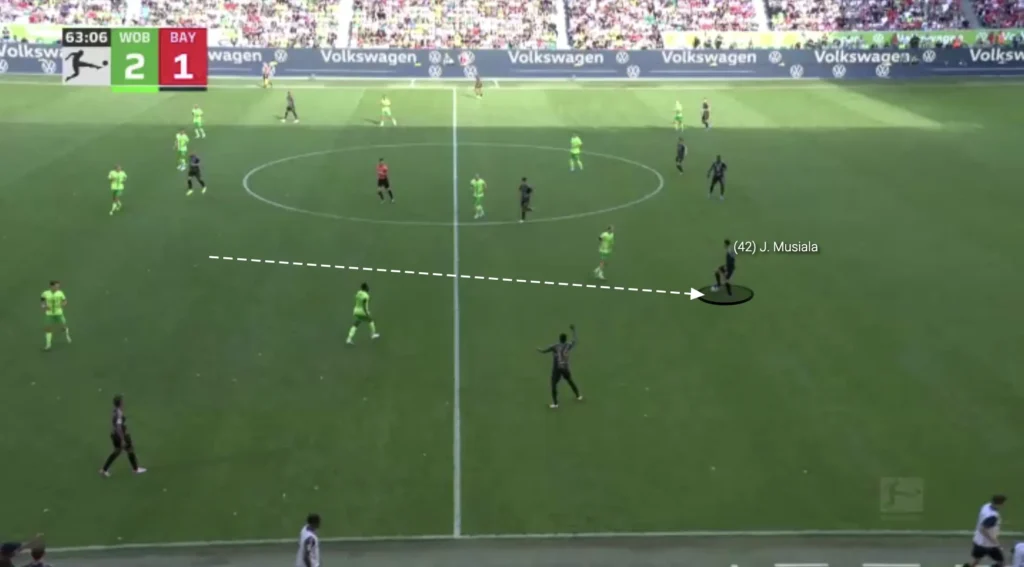
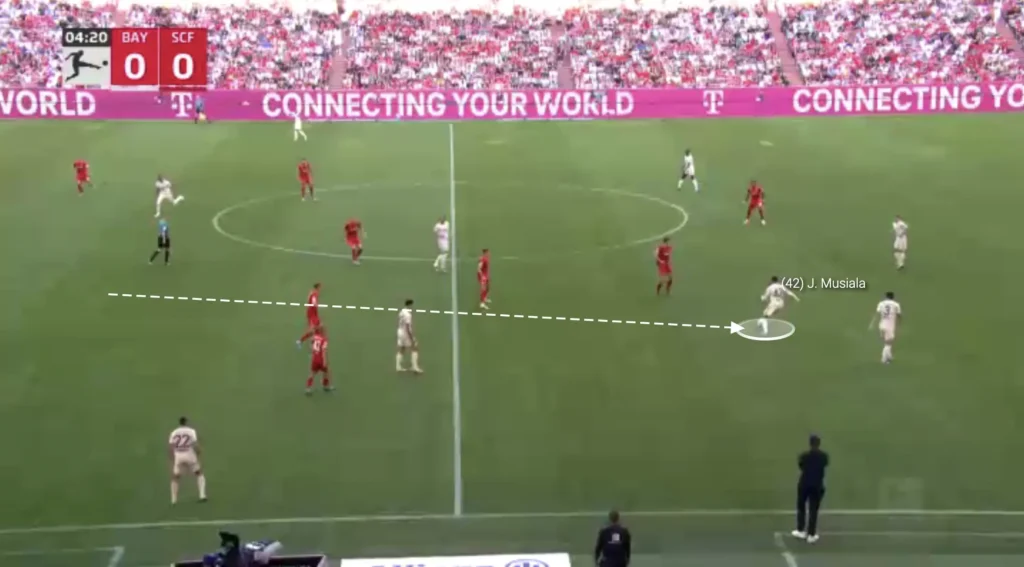
In Vincent Kompany’s tactical system, Harry Kane frequently drops deep as well. This movement is pivotal as it allows Kane to act as a link between the midfield and the attack, drawing defenders out of position and creating space for his teammates to exploit.
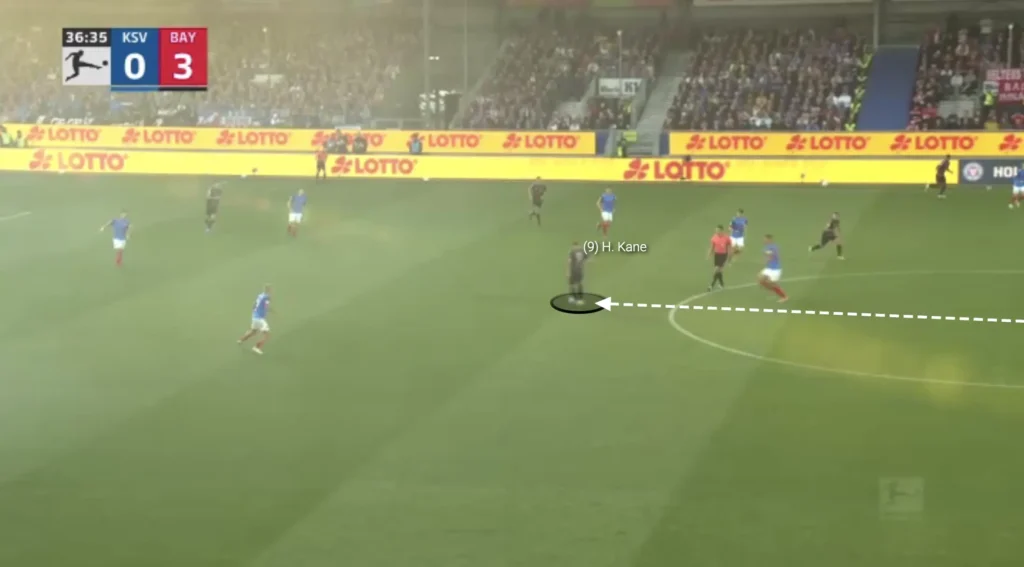
Kane’s vision and passing accuracy enable him to distribute the ball efficiently, often initiating dangerous attacking moves. Additionally, his strength and ball control help him hold up play under pressure, allowing Bayern to maintain possession and build attacks methodically.
Finding the Pockets
Kompany’s players always try to find the attacking midfielders in the pockets. These “pockets” refer to the spaces between the opposition’s defensive and midfield lines, where the attacking midfielders can receive the ball in more advanced positions. By positioning themselves intelligently in these pockets, the attacking midfielders can turn quickly and face the opposition’s goal, creating opportunities for through balls, driving runs, or direct shots. This positioning forces the opposition to make difficult decisions. If an opposition defender steps up and closes down the attacking midfielder, he potentially leaves space behind. If he stays back, he allows the midfielder time on the ball. The Bayern defenders and holding midfielders will look for straight passes, breaking the opposition lines and finding the attacking midfielders who can turn and drive at the defense.
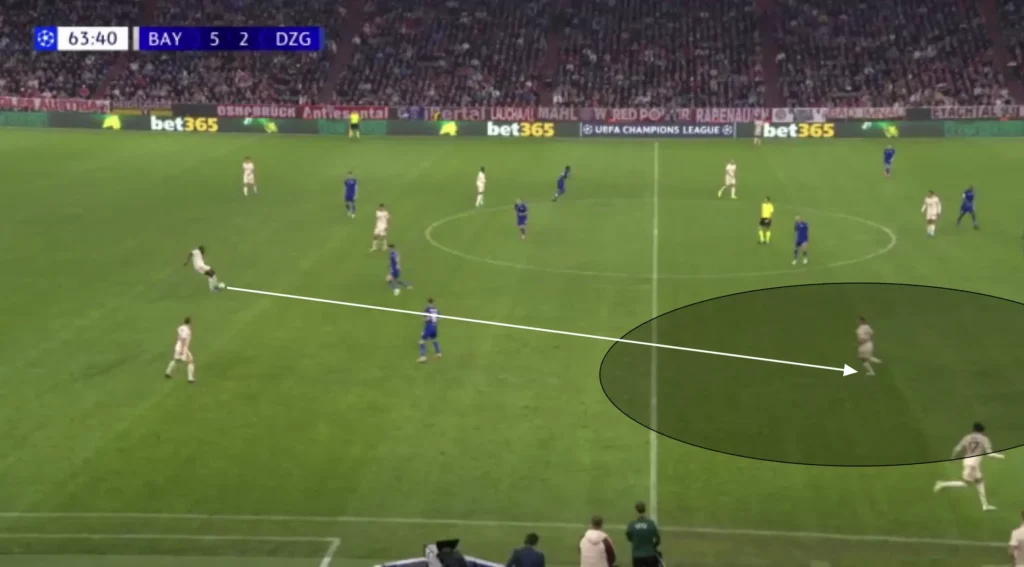
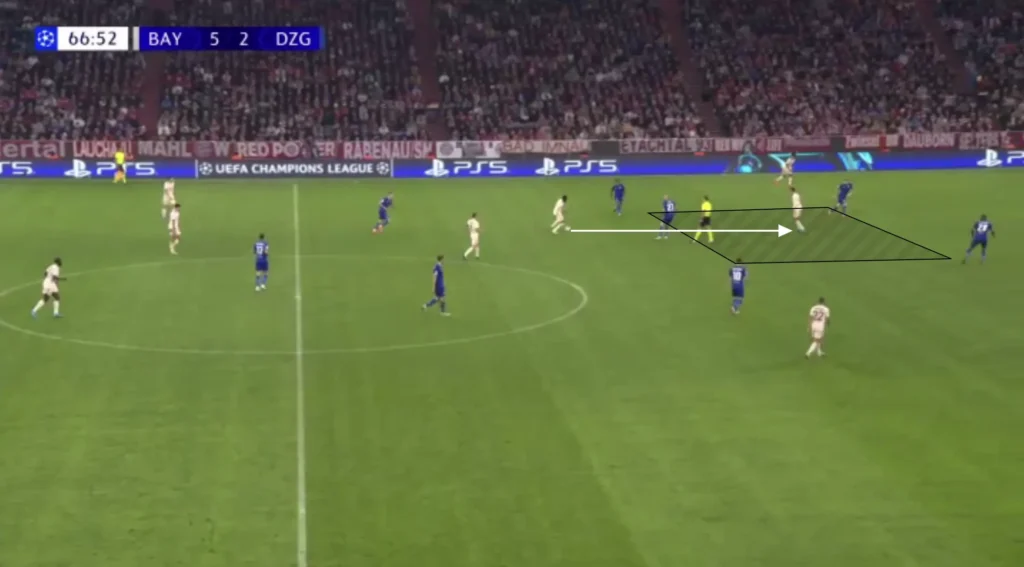
Finding these pockets is crucial for maintaining fluidity in attack and ensuring that the team can progress the ball effectively through the middle of the pitch.
Numerical Advantage Against the Opposition Backline
Another massive aspect of Bayern’s high build-up is their ability to create numerical advantages against the opposition’s defensive line. Playing with a front five means the forward line naturally becomes numerically superior against a back four, which they are great at taking advantage of.
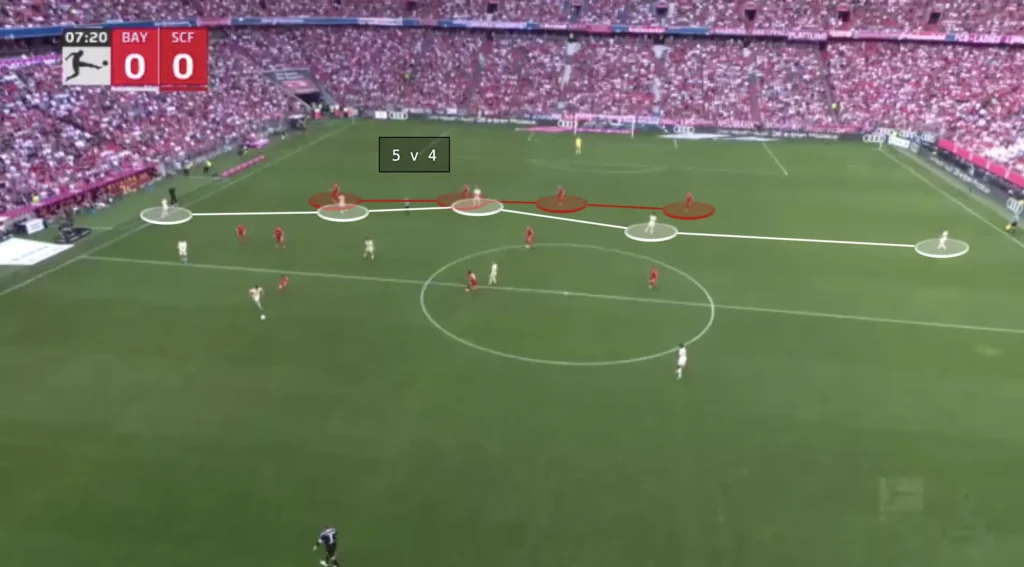
They mainly exploit this by creating 2v1 situations against the opposition fullback. When the defending team is positioned on one side, the weak-side fullback becomes vulnerable to the long switch of play due to the 1v2 against Bayern’s winger and attacking midfielder.
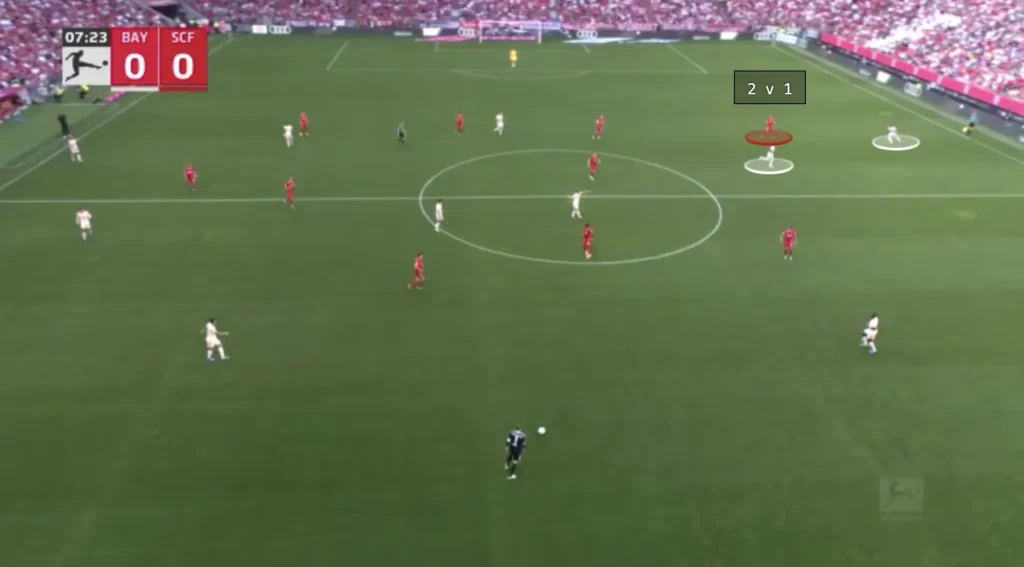
Bayern’s attacking midfielder will often make a run in behind, forcing the fullback to follow that run, and opening the space for the winger out wide. Kompany’s team often capitalizes on this by getting the ball to the winger and creating many opportunities from 2v1 situations on the wing and in the half-spaces.
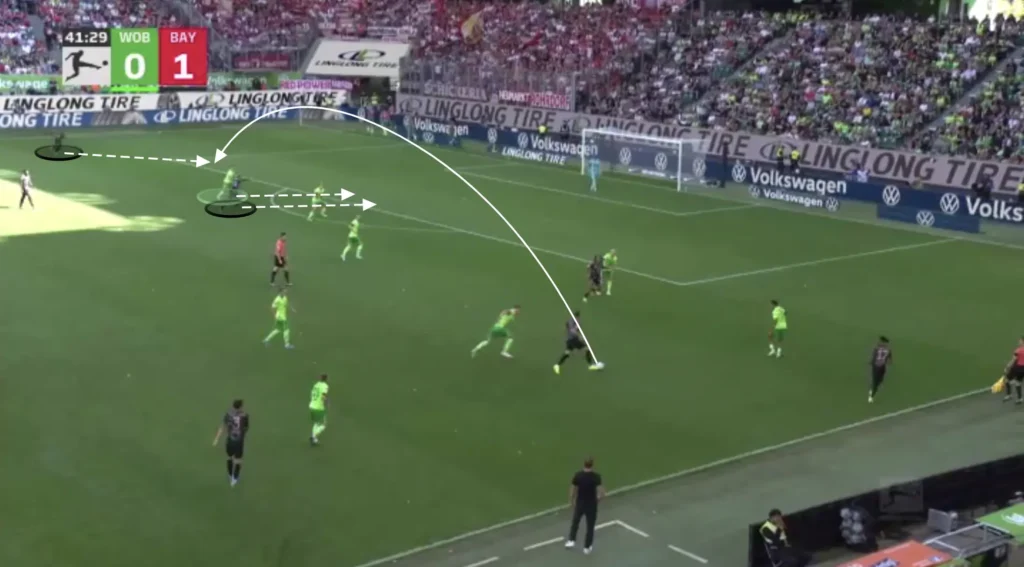
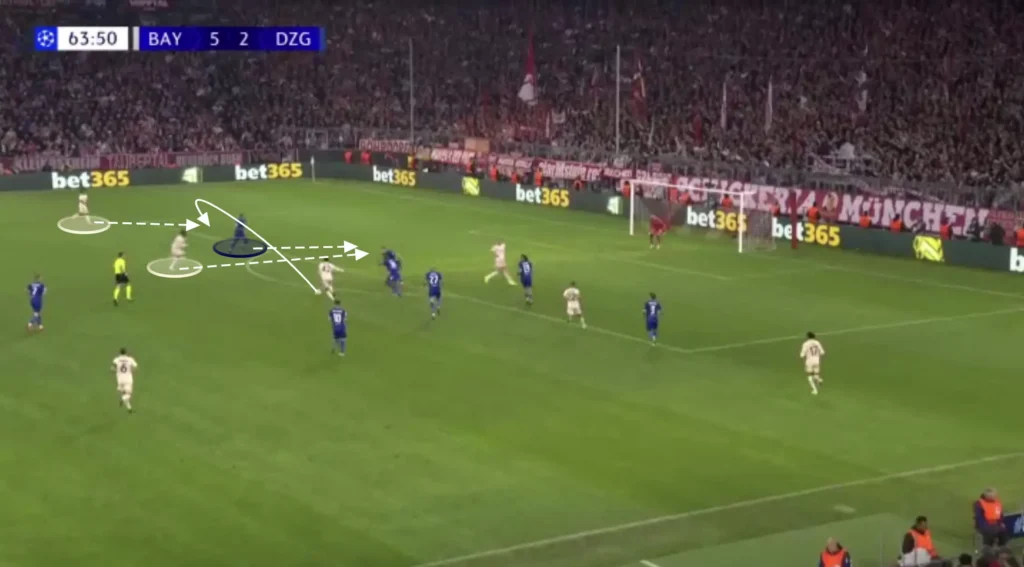
Counter-Movements
Bayern Munich will also use counter-movements between the winger and attacking midfielder to exploit this numerical advantage. When the ball is in the backline or with the goalkeeper, the winger can make a run in behind while the attacking midfielder drops deeper. This creates a question for the opposition fullback. If he pushes up on the dropping midfielder, the space behind him opens up, allowing Bayern to play a through-ball to the running winger. However, if he stays inside to cover the run, the ball can be played to the attacking midfielder, who can receive the ball, turn, and attack the defense.
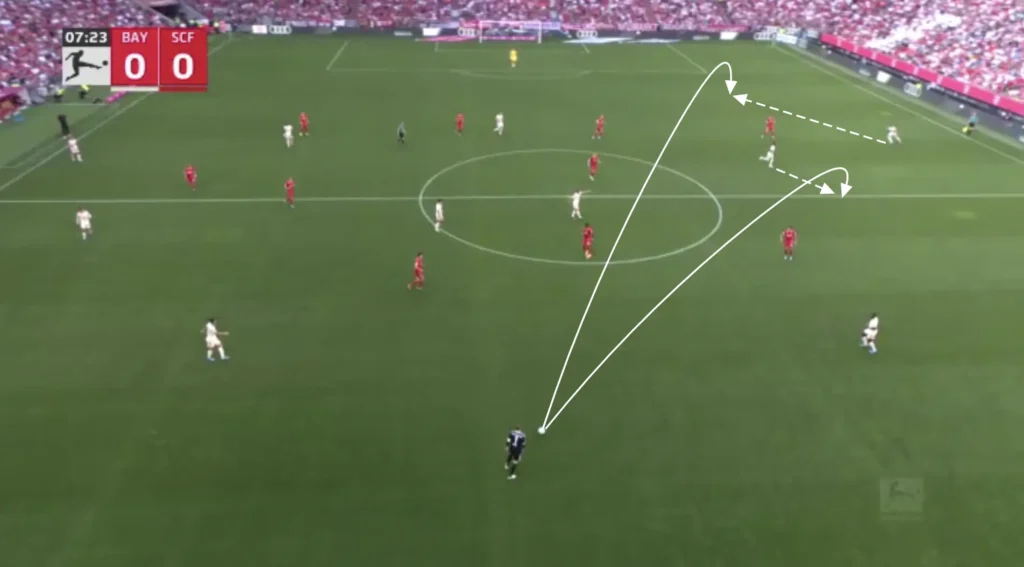
The Bayern Munich attackers will use counter-movements like these all the time. When one attacker drops, the other will go in behind, constantly creating questions for the opposition defenders.
Final Third
Attacking the Half-Space
Kompany’s players usually look to create chances by attacking the space between the opposition center-back and fullback. They primarily do this from the wide areas with underlaps from the attacking midfielders. When the winger receives the ball out wide he will attract the opposition fullback. This opens the space between the fullback and the center-back, which allows Bayern’s attacking midfielder to make the underlapping run into this space. The ball can be played to the underlapping player, who can cross the ball into the box or attack his defender in a 1v1 situation.
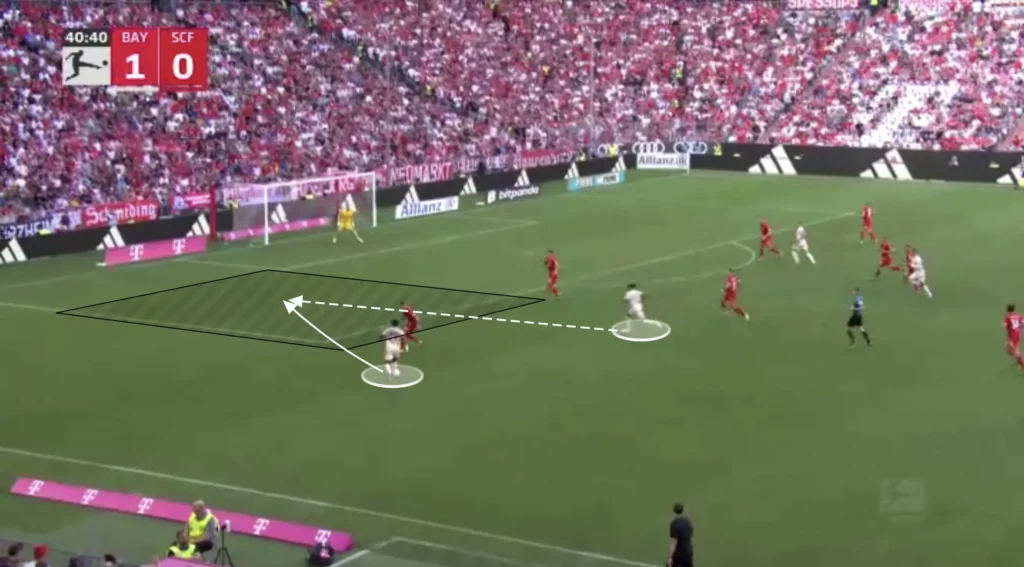
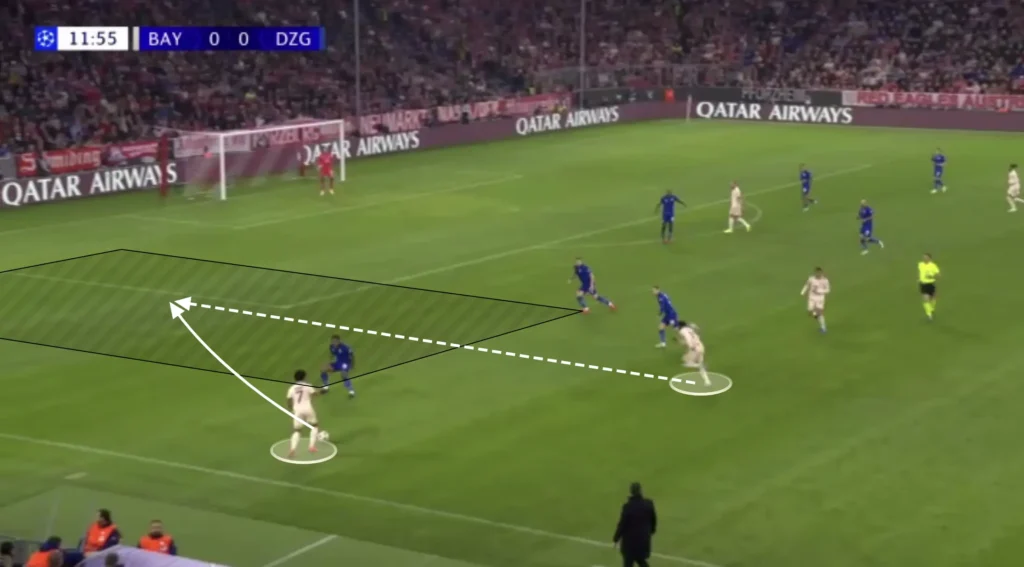
The winger does not have to play the ball to the underlapping player. The run from the attacking midfielder will often drag away an opposition defensive midfielder, which opens the space inside. The winger can take the ball inside and shoot or find a pass to a free player in front of the backline.
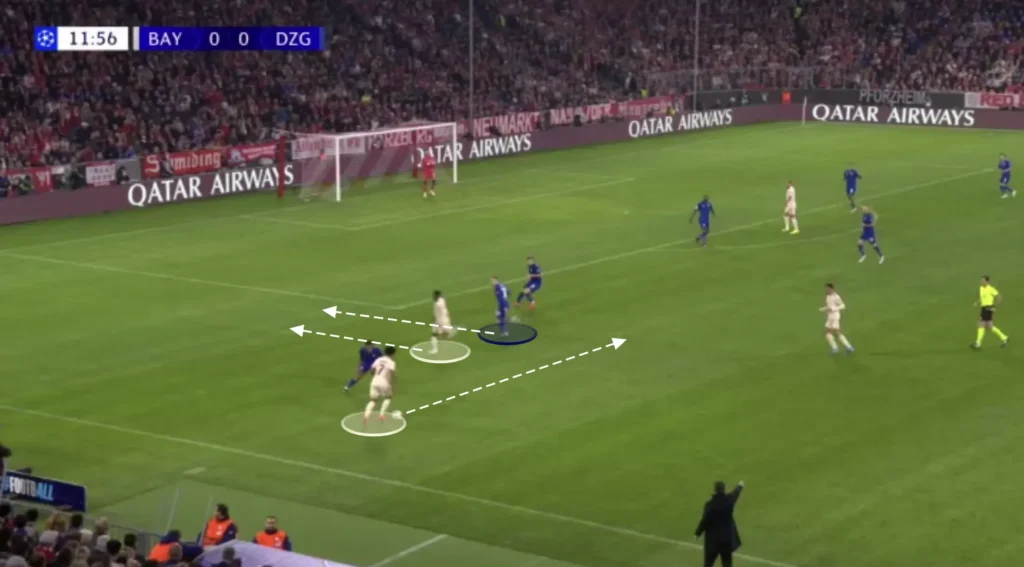
Overlaps
Bayern Munich will also use overlaps to produce opportunities in the final third. When the winger gets the ball and the fullback is nearby, the fullback can make the overlapping run, creating a 2v1 against the opposition fullback. If the opposition fullback drops to cover the overlapping run, the winger could cut inside, taking a shot or combining with a midfielder. If the fullback covers the center, the ball can easily be played to the overlapping player, creating a crossing opportunity.
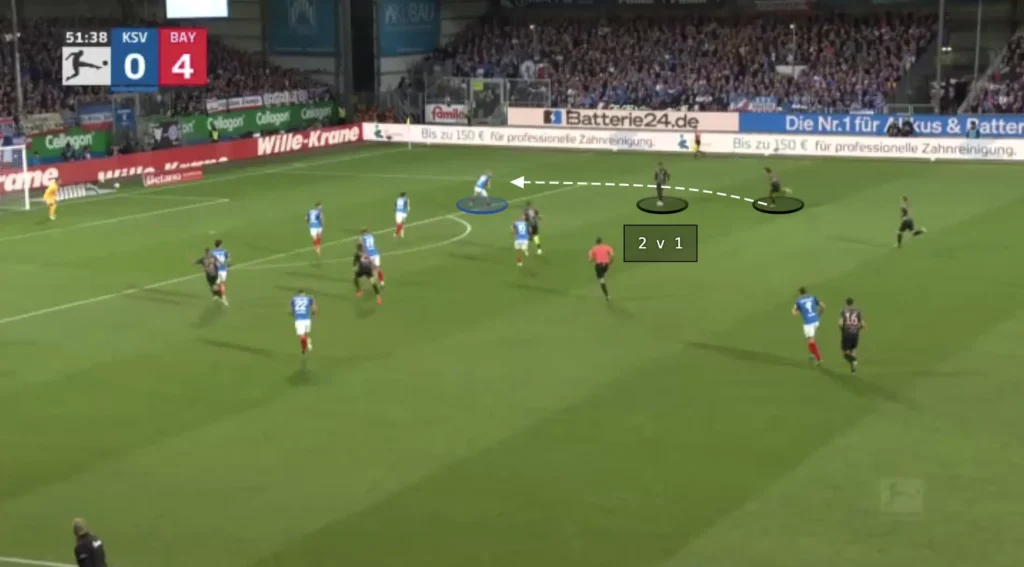
Many Players in the Box
The attacking midfielders and wingers look to make runs into the box when the ball is in the final third, often getting four or five players into these areas to create overloads. The numerical advantages in the box increase the chances of connecting with the cross, as more players present multiple targets for the crosser, making it harder for defenders to mark everyone effectively. Additionally, having multiple players in the box provides options for different types of finishes, whether it’s a header, volley, or a quick tap-in. It also allows for better positioning to react to second balls or rebounds, increasing the likelihood of capitalizing on any defensive errors.
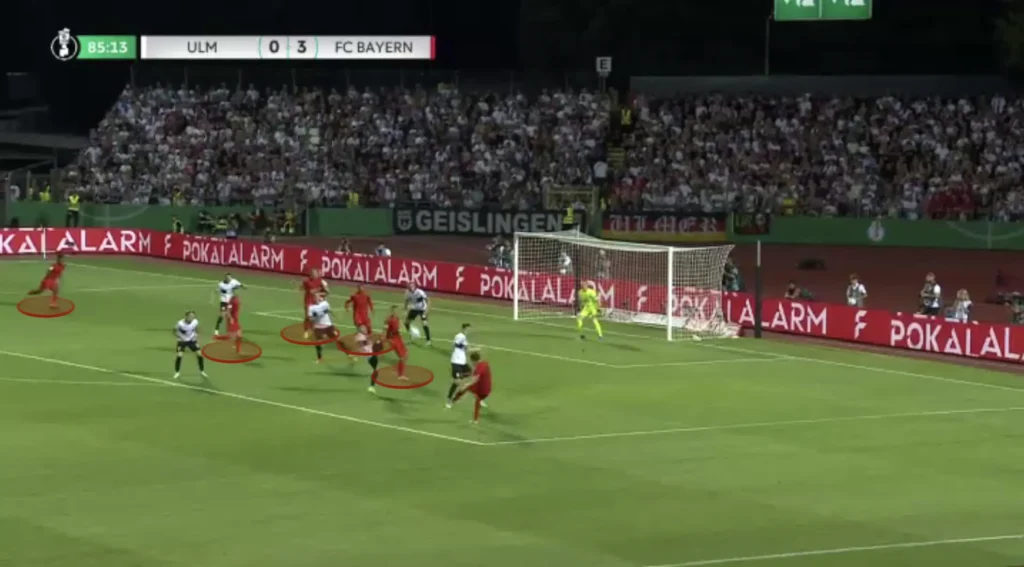
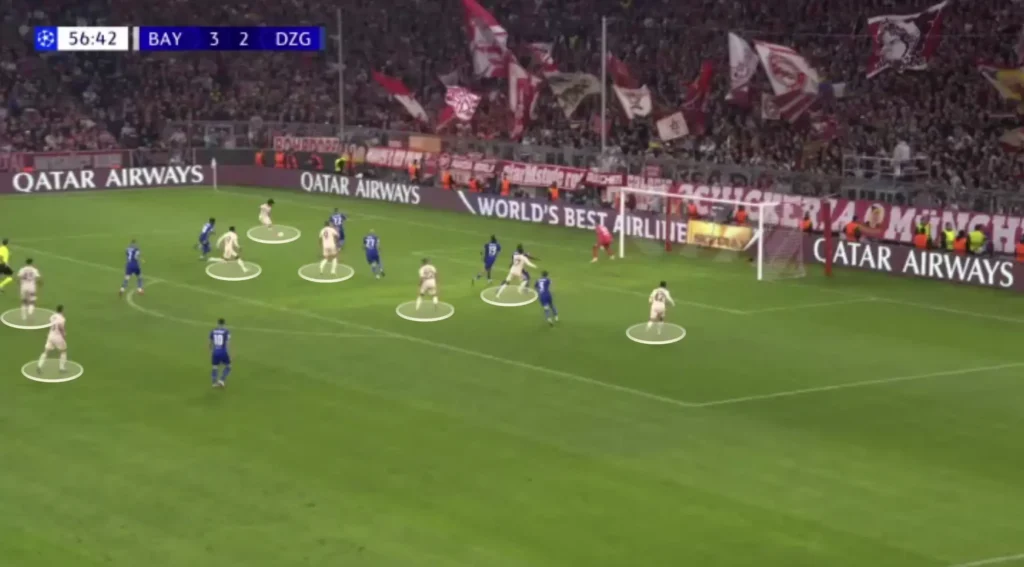
Kompany also positions many players outside the box, ready for the second balls and cut-backs. Bayern will often create crossing opportunities, which pushes down the opposition’s defense and opens the space in front of the opposition’s backline. The holding midfielders can collect any loose balls or be found directly in these spaces with cut-backs, and from there, they can shoot or combine with an attacker to create goalscoring opportunities.
Defending
Man-to-Man
Kompany’s Bayern Munich defends in a man-to-man system all over the pitch. Everyone has an opposition player they are responsible for marking, which makes it difficult for the opposition to find open players. This intense pressure forces the opposing team into hurried decisions, often resulting in turnovers in dangerous areas. When defending man-to-man, the players must be good at defending 1v1 situations. If they are not and the opposition players win the 1v1 duels to get past their player, another player has to leave their marking, and the entire defensive structure collapses. Bayern’s defensive setup is one of their greatest attacking threats, as they score many goals from winning the ball high up and counterattacking.
They use the man-to-man defending setup in both the high press;
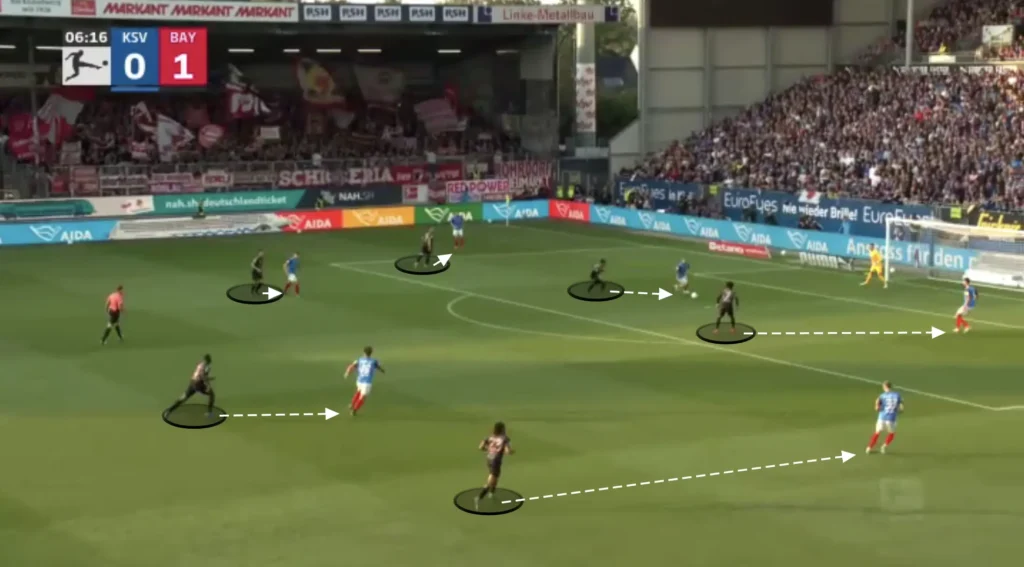
And lower down the pitch:
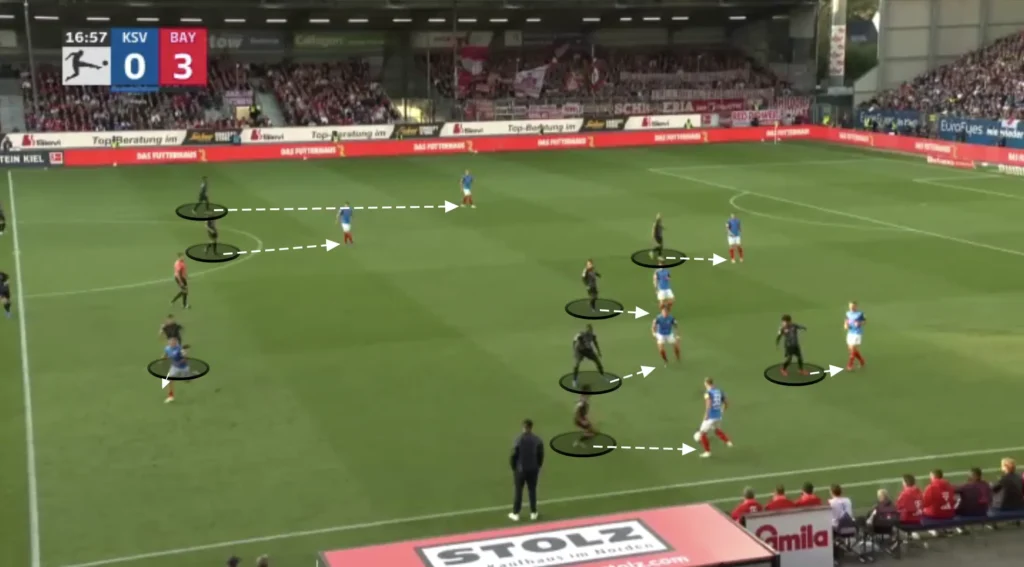
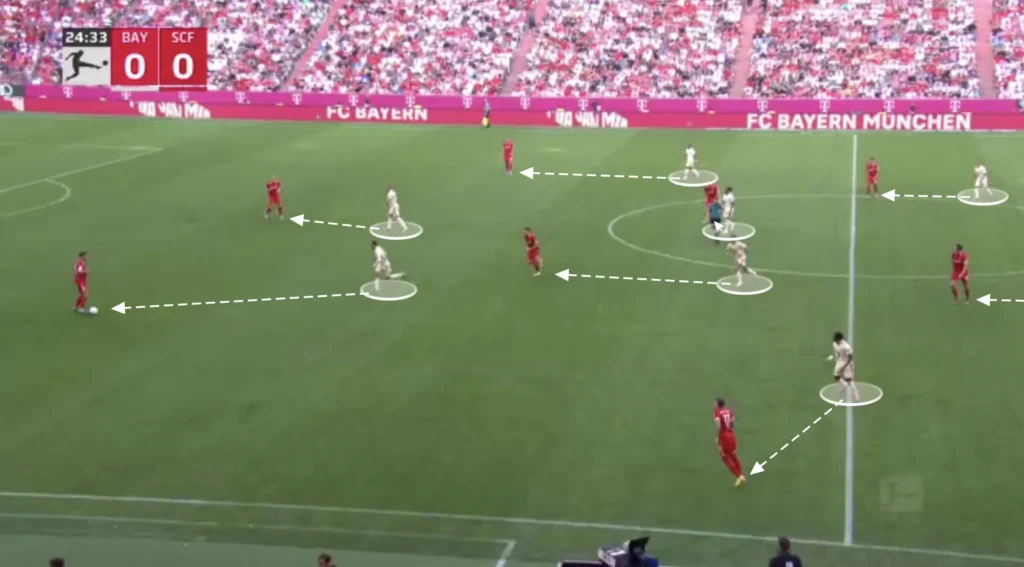
Distance Marking
In a man-to-man system, it becomes crucial that the players know when to mark the opponent they are responsible for and when not to. The Bayern players will always have an opposition player for whom they are accountable. However, they will never be closer to them than they need to be. If an opponent, for example, is very far from the ball, the Bayern player marking him does not need to be as close to him. He can instead come in and help create numerical superiorities in the center, decreasing the risk of dangerous 1v1 situations.
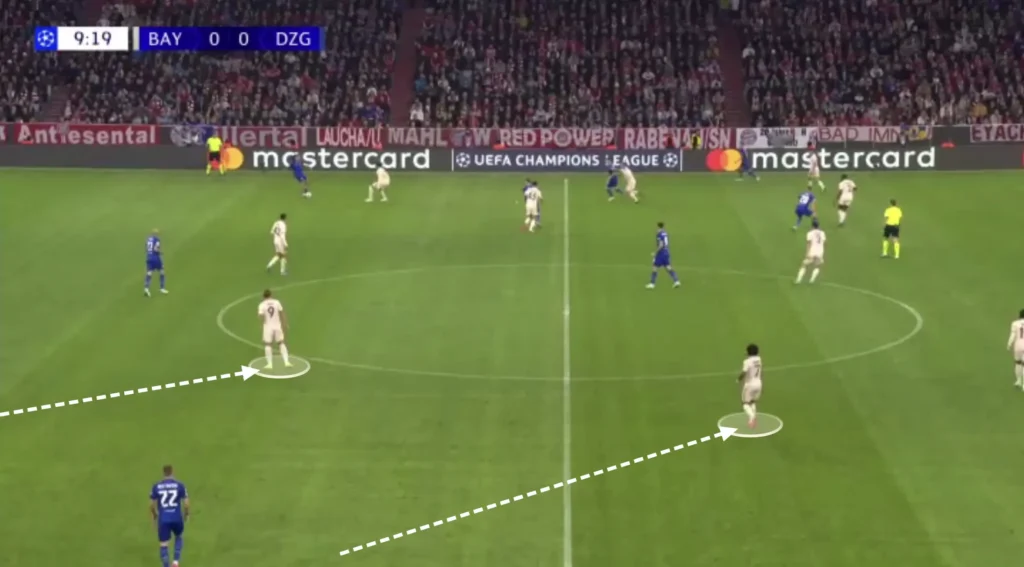
A rule of thumb for the players is that the closer you are to the ball, the closer you need to be to your opponent. The further away you are from the ball, the further away you can be from your opponent.
Squeezing the Pitch
Additionally, Kompany wants his team to squeeze the pitch when defending. This means constantly pushing the team up as much as possible. Every time the opponent plays a slow, sideways pass or a back pass, the Bayern player man-marking the opposition player who receives the ball pushes up. When this happens, the rest of the team has to follow to stay compact. When the next pass comes, the next player pushes up, forcing the opponent back even more. They do this because it forces the opponent further from the Bayern Munich goal, making it harder to create chances.
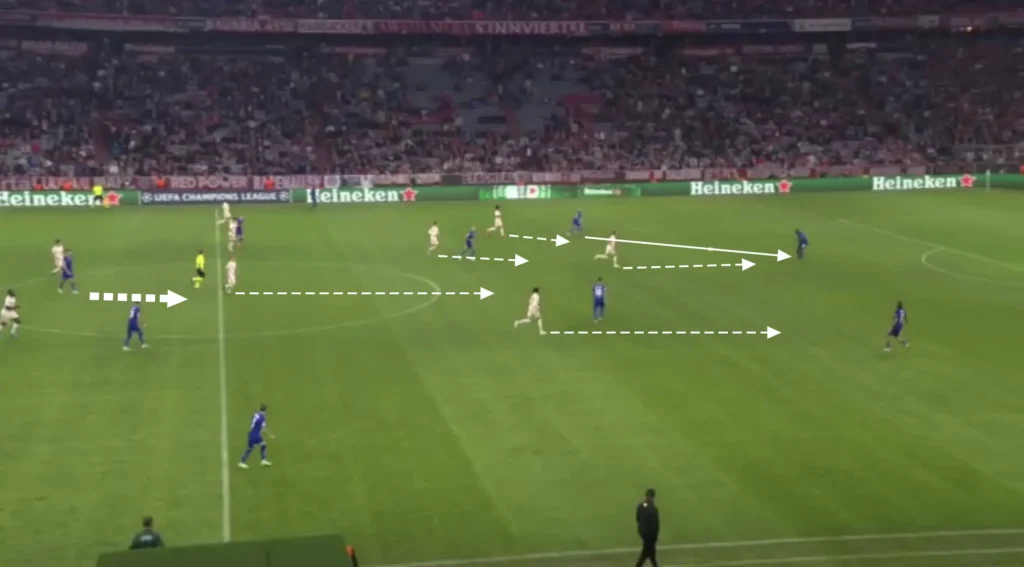
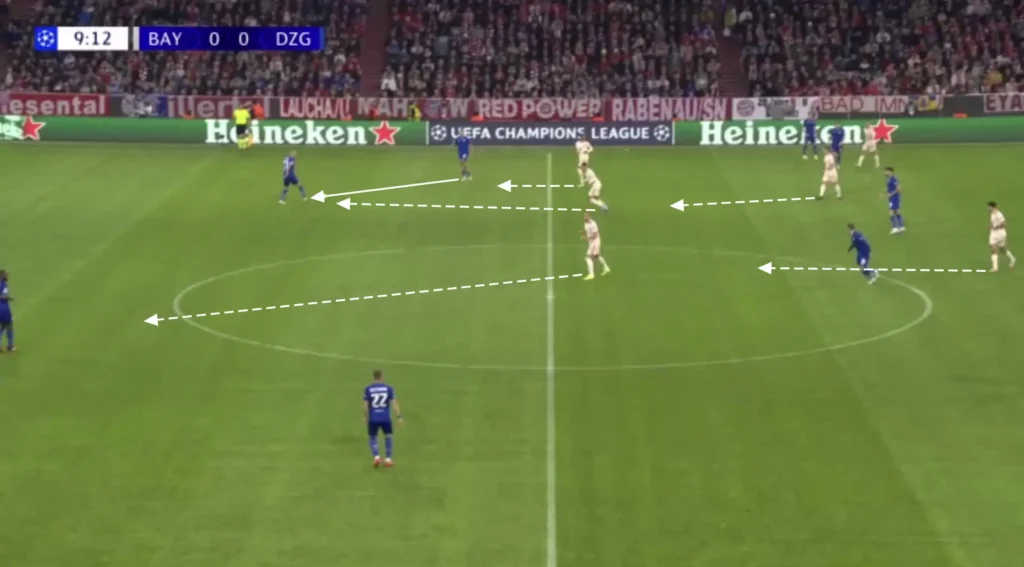
Issues with the Man-to-Man Press
Pressing in an aggressive man-to-man system comes with significant risks. While it can force mistakes and win the ball high up the pitch, it leaves large spaces vulnerable to exploitation. If just one player is beaten or fails to track their man, the opposition can easily bypass the press, creating numerical advantages in key areas. This system requires perfect coordination and constant high energy; if fatigue sets in or communication breaks down, it can leave the defensive line exposed.
Additionally, aggressive pressing opens up gaps in wide areas or behind the defense, making the team susceptible to early through-balls. If an opposition midfielder gets time on the ball, he can find an attacker making a run in behind the backline, creating all sorts of issues for the Bayern Munich defenders.

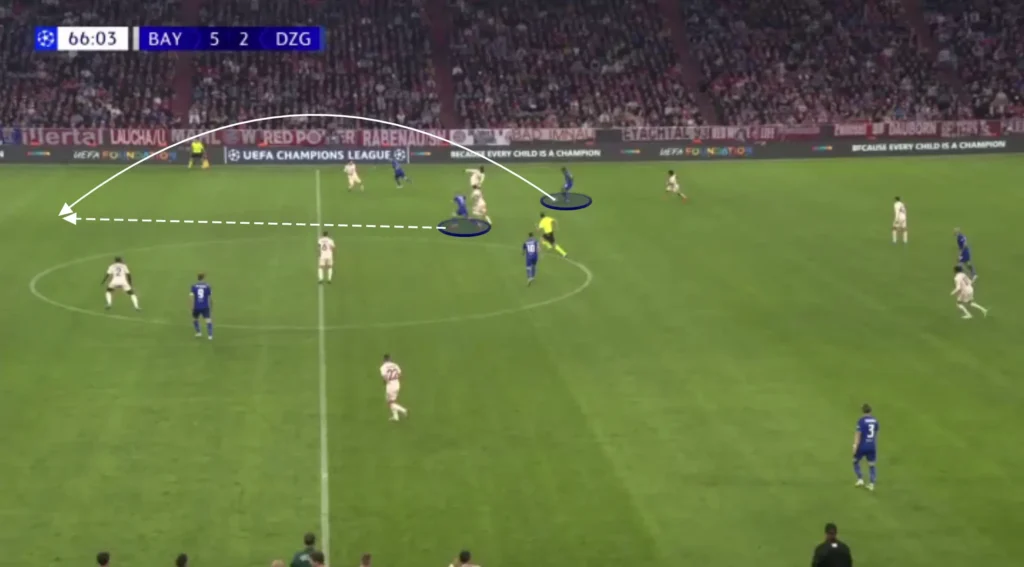
Final Thoughts
In conclusion, Vincent Kompany’s Bayern Munich demonstrates a tactical evolution that blends discipline with creativity, reflecting the influence of his years as both a player and coach. His approach emphasizes solid defensive organization, fluid transitions, and aggressive pressing, making Bayern a formidable force on both ends of the pitch.
Kompany’s tactical insight has allowed Bayern to maintain their attacking identity while incorporating a more resilient and adaptable structure. As he continues to refine his system, Bayern’s tactical framework under his leadership promises to make them even more competitive at the highest levels.
